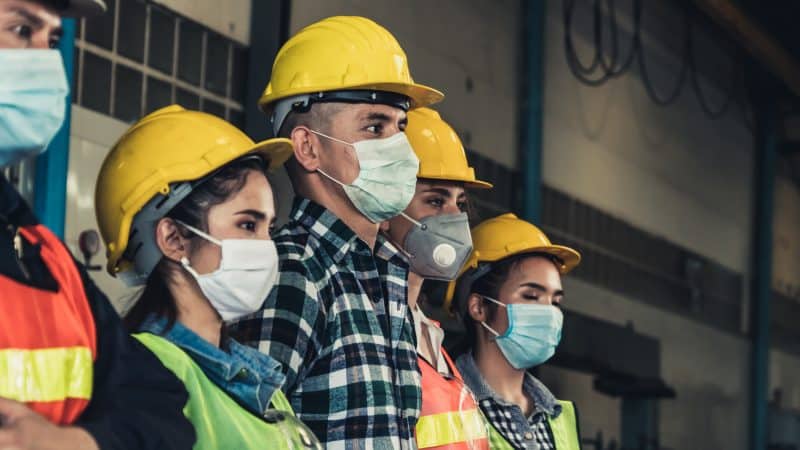
Like a lot of employers, Dean Burrows is looking for help these days.
Many of the experienced machinists at Gear Motions, the company Burrows runs in Syracuse, N.Y., took early retirement during the pandemic. And finding replacements has not been easy.
“We’re not just competing against other manufacturers,” Burrows says. “We’re competing against the McDonalds, the Amazons. So it becomes challenging to try to position yourself as a company that people want to come to work for.”
Burrows has boosted wages by 20%, and he’s offering to train less-experienced workers. But it’s still a struggle to find people — especially for the second shift, which stretches until 3 a.m.
As a result, Burrows has been telling customers they might have to wait longer for the specialty gears his company makes for cars, oil field pumps and medical devices. He has even turned down some orders out of concern he won’t be able to deliver.
“We don’t want to risk our reputation because we can’t find employees to be able to produce the product,” he says.
That scenario is being repeated across many industries, as businesses struggle to fill a record number of job openings. American Airlines was forced to trim its flight schedule this summer. Theme parks have had to limit their hours. And restaurants are keeping their doors closed one or two days a week.
That’s weighing on the broader economic recovery. The Federal Reserve Bank of Atlanta estimates staffing shortages are costing U.S. businesses more than $60 billion a month in lost sales.
Even wedding and bridal showers are getting a “no”
Businesses have been hiring rapidly, adding more than 1.8 million workers just in June and July. But millions of people who were working before the pandemic are still on the sidelines. And that’s creating challenge for companies as they try to keep pace with rapidly growing demand.
“We can only fill 75% of our order requirements due to the labor shortage,” one factory manager told the Institute for Supply Management last month.
Anne Boninsegna, who runs an eating and event space, has even said “no” to some wedding parties and bridal showers because she can’t hire enough servers or bartenders.
“It’s sad and it’s disappointing, especially after sitting empty for so long,” says Boninsegna, co-owner of The Kitchen in Columbus, Ohio.
Before the pandemic, Boninsegna says, she used to have plenty of applicants for bartending and serving jobs. Now, the few people who do apply often don’t even show up for an interview.
“I’ve had lots of conversations with colleagues and we just say, ‘Where did they go? Did they become independently wealthy during the pandemic?’ ” Boninsegna says. “People who would normally function as bartenders, it feels to me like they’re all out there going out to festivals and traveling the country and living out their passion and stuff.”
A game of musical chairs where workers are finding a better seat
Boninsegna is partly joking, but the pandemic has indeed changed the way a lot of people think about work. A Washington Post poll this summer found nearly one out of three workers under the age of 40 are reconsidering their careers. People have been quitting low-wage jobs in restaurants and retail at especially high rates, according to the Labor Department.
Some economists are not bothered by that.
“There is just more churn than normal,” says Betsey Stevenson, a former White House economist who is now at the University of Michigan. “It’s like a giant game of musical chairs, and it’s taking everyone longer than usual to find a good seat for themselves.”
Eventually, Stevenson says, that extended search is likely to result in workers finding better jobs, where they’ll be happier and more productive.
An amusement park worker operating two rides!
If short-staffing forces a restaurant to close its doors one day a week, customers might just go down the street to another dining spot. But with labor shortages so widespread, some consumer spending is lost for good.
“I’ll give you a personal example,” says Sarah House, an economist at Wells Fargo. “I was going to take my kid to the local amusement park until I talked to a friend and heard that lines were so long because they had one worker operating two rides because they couldn’t find enough staff. So we skipped that trip and that’s money that we didn’t spend elsewhere.”
The competition among employers has been good for workers’ pocketbooks, as average wages have risen. But many employers are passing along the added cost in higher prices, which is contributing to rising inflation. The burrito chain Chipotle, for example, raised prices 3.5% to 4% this summer, after boosting its average pay to $15 an hour.
Workers are feeling burnout, but relief in the form of additional hires may be hampered by the delta variant
Forecasters have been counting on more people coming back to work this fall, as vaccination rates rise, supplemental unemployment benefits run out in states where they haven’t already ended, and schools reopen, offering relief to working parents.
Unfortunately, the latest jump in coronavirus infections could jeopardize that timeline.
“I’m particularly worried about schools,” said Cecilia Rouse, who leads the president’s Council of Economic Advisers. “If schools are not able to open robustly and to stay open, it will make it very difficult for caretakers to rejoin the workforce.”
In the meantime, those who are working are struggling with burnout.
Boninsegna worries that her Columbus kitchen staff is stretched too thin, and she’s pleading with customers to be patient.
“Staffing levels are not what they were,” she says. “So if it takes a little bit longer to get something, there’s a good reason behind it. It’s not just people being lazy and not doing their job.”





























